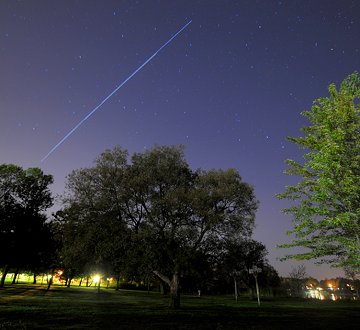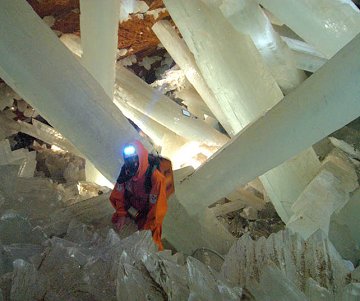| HUBBLE LIVES! Back in May, astronauts visited the Hubble Space Telescope to install new hardware and make repairs to the aging observatory. The upgrades were a sucess. To prove it NASA today released spectacular first images from the rejuvenated Great Observatory. Get the full story from Science@NASA. DOUBLE FLYBYS: Space shuttle Discovery and the International Space Station (ISS) undocked on Sept. 8th, and now they're circling Earth side by side. Hours after the split, Malcolm Park photographed the two spaceships gliding through the stars above Port Perry, Ontario: 
"They were so close together," says Park, "their streaks overlapped. The two spaceships were very bright." Discovery is slowly moving away from the ISS as it positions itself for landing on Thursday. Until then, the double flybys will continue. Check the Simple Satellite Tracker for viewing times. more images: from Phillip Chee of Peterborough, Ontario; from Mihir Devare of Oxford, Ohio; from Gina Scaccia of Ashland, Oregon; from Clair Perry of Charlottetown, Prince Edward Island, Canada; from Martin Popek of Nýdek, Czech Republic; from Val Germann of Columbia, Missouri; from John Minnerath of Crowheart, Wyoming; INNER SPACE TERRANAUTS: This week, while astronauts orbited high above Earth installing new science equipment in the laboratories of the International Space Station, a team of terranauts descended into the Earth on their own mission of discovery. "We were not in outer space, but inner space," says explorer George Kourounis, who sends this picture from the Cave of Crystals in Naica, Mexico: 
more images: #1, #2, #3, #4
Three hundred meters below Naica lies an alien world of giant crystals and nearly unbearable heat. "With an air temperature of 122 F and a relative humidity of more than 90%, it feels like 228 F in the cave," says Kourounis. "To survive in this extreme environment, we enter the cave wearing special suits with cooling packs inside and a backpack respirator which allows us to breath chilled air. Even with all this equipment, I will still be able to stay in the cave for no more than 45 minutes at a time." Unprotected, even a scant 10 minutes could prove fatal--and that is why this amazing cavern discovered by miners nine years ago remains relatively unexplored. "Some of the crystals are 11 meters long and weigh as much as 55 tons," marvels Kourounis. "We had to be extremely cautious not to slip and fall. Doing so could get you impaled." "Wearing the suit," he adds, "you feel like an astronaut who is about to go on a space walk." Make that an inner space walk. Click here for more pictures and anecdotes from the Cave of Crystals.
August 2009 Aurora Gallery
[previous Augusts: 2008, 2007, 2006, 2005, 2004, 2003, 2002, 2001]
Explore the Sunspot Cycle | 
